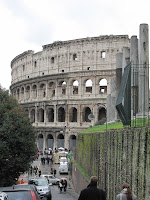This weekend (Feb. 6-8) Sara and I made a point of going to visit the downtown area. On Friday, however, I visited the Instituto Nazionale per la Grafica behind the Trevi Fountain with my printmaking class. We saw original prints by Durer, Rembrandt, Piranesi, Goya, and others, as well as the original plates for a Piranesi print and a couple other artists. It was raining, though, so I didn't go see anything else that day.

Saturday we went to the Palatine Hill museum and the Forum Romanum (Roman Republican forum). I can't post all my pictures here because I took so many, but it was great to see all the buildings that I've been studying and can identify on sight by now. We spent several hours climbing all over the site looking at everything. One of the most impressive ruins is the Basilica of Maxentius, which is just immensely large. The Museo Palatino (Palatine Hill) isn't quite as interesting because it was just a lot of brick walls from houses--first the patricians and then the imperial family had their homes there, overlooking the valley of the Forum.




Today, Sunday, we got up early to go see the Colosseum. Note to anyone thinking about visiting Rome: Be sure to buy your ticket for the Colosseum in advance! The ticket is a combo ticket for the Colosseum, Palatine, and Forum, and lasts for two days, so I'd recommend doing what we did: spend one day in the Forum and Palatine, and go the next day to the Colosseum. The line for tickets at the Colosseum is extremely long and slow, while there was no line at all at the ticket office at the entrance to the Palatine. Since we already had tickets, we were able to walk right into the Colosseum without waiting! And go early, it gets crowded. Still, it's something that everyone has to see, and you can get great views of the Arch of Constantine from the upper level.


After the Colosseum we went to the Campidoglio, the piazza on top of the Capitoline Hill designed by Michelangelo (behind the Vittoriano monument), where the Capitoline Museums are now located. From behind this piazza you can really see the Forum well, and the piazza itself is very pretty. Tonight I'm making black bean soup and working on my new printmaking project, drypoint engraving!


Saturday we went to the Palatine Hill museum and the Forum Romanum (Roman Republican forum). I can't post all my pictures here because I took so many, but it was great to see all the buildings that I've been studying and can identify on sight by now. We spent several hours climbing all over the site looking at everything. One of the most impressive ruins is the Basilica of Maxentius, which is just immensely large. The Museo Palatino (Palatine Hill) isn't quite as interesting because it was just a lot of brick walls from houses--first the patricians and then the imperial family had their homes there, overlooking the valley of the Forum.




Today, Sunday, we got up early to go see the Colosseum. Note to anyone thinking about visiting Rome: Be sure to buy your ticket for the Colosseum in advance! The ticket is a combo ticket for the Colosseum, Palatine, and Forum, and lasts for two days, so I'd recommend doing what we did: spend one day in the Forum and Palatine, and go the next day to the Colosseum. The line for tickets at the Colosseum is extremely long and slow, while there was no line at all at the ticket office at the entrance to the Palatine. Since we already had tickets, we were able to walk right into the Colosseum without waiting! And go early, it gets crowded. Still, it's something that everyone has to see, and you can get great views of the Arch of Constantine from the upper level.


After the Colosseum we went to the Campidoglio, the piazza on top of the Capitoline Hill designed by Michelangelo (behind the Vittoriano monument), where the Capitoline Museums are now located. From behind this piazza you can really see the Forum well, and the piazza itself is very pretty. Tonight I'm making black bean soup and working on my new printmaking project, drypoint engraving!

Comments
Post a Comment